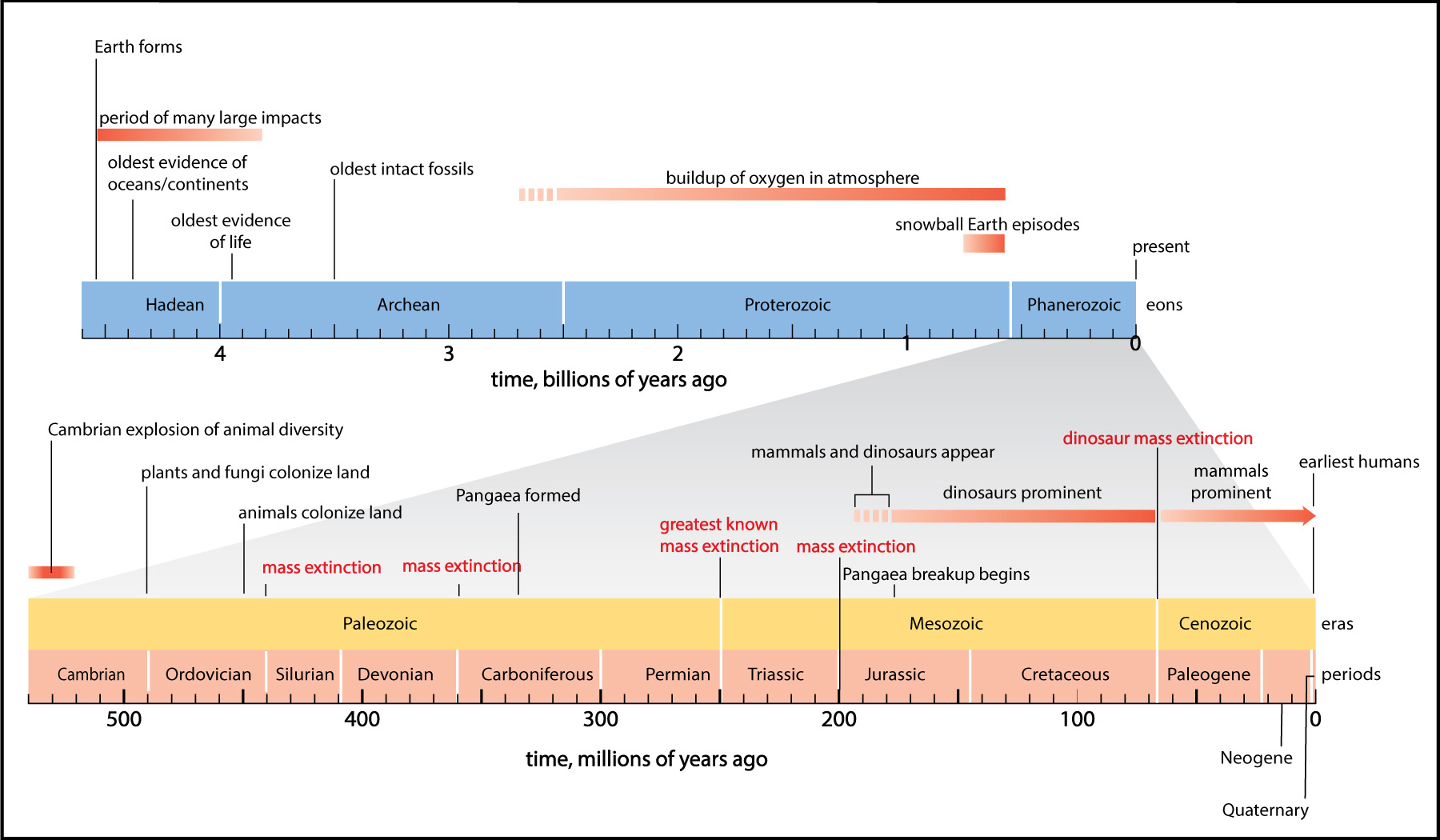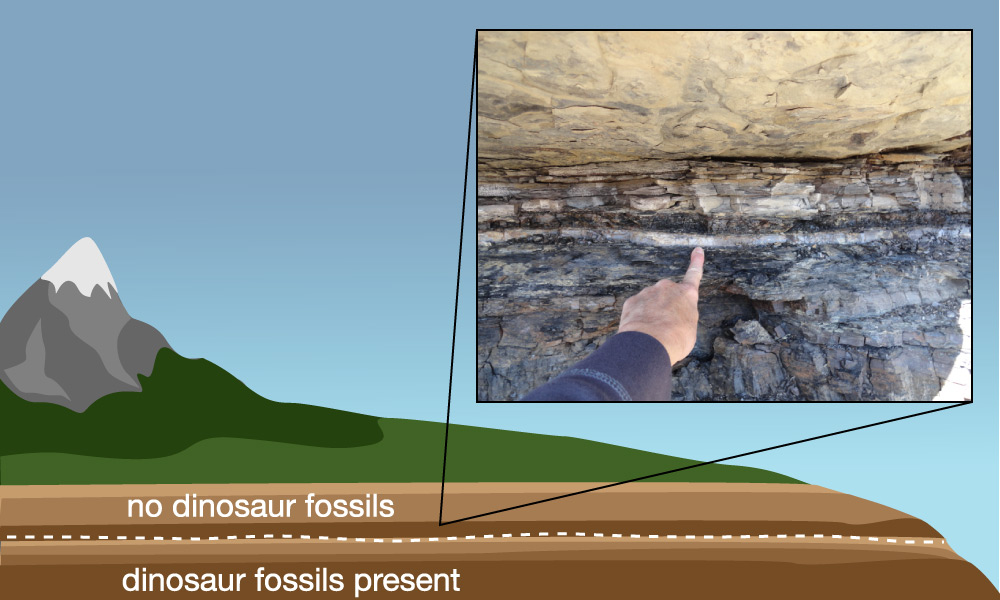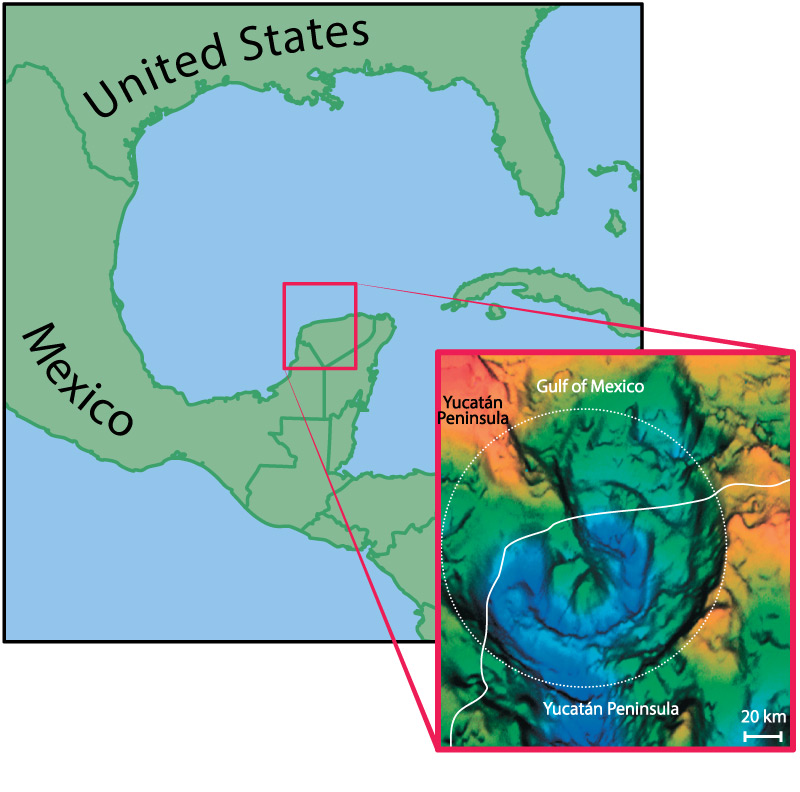The last mass extinction shown in Figure 5.4–1 (repeated again below) is the most famous one of all: It is labeled the “dinosaur mass extinction,” because it was the one in which living dinosaurs disappeared from Earth . However, it wasn’t just the dinosaurs that were lost. As with other mass extinctions, a large fraction of all plant and animal species were permanently erased from our planet. What killed them all off?

First, to make sure you understand how scientists know that the extinction occurred, try the following questions.
Discuss the following questions with a classmate. Then click to open the answers to see if they agree with what you came up with.
- The mass extinction that killed off the dinosaurs is sometimes called the “Cretaceous-Paleogene” event . Why does it have this name?
The name comes from the fact that, as you can see in Figure 5.4–1, the dinosaur mass extinction marks the division point between the Cretaceous and Paleogene periods.
- Suppose you were looking for fossils in the sedimentary layers in the walls of the Grand Canyon, and you were looking in a layer dating to the Jurassic period. Would it be possible for you to find any fossils of dinosaurs? Explain.
Yes, because Figure 5.4–1 shows that dinosaurs were living during the Jurassic period.
- Again suppose you were studying fossils in the sedimentary layers in the walls of the Grand Canyon. How would you know when you had reached a layer dating to the Paleogene period?
Below this layer, you would find fossils of dinosaurs. But there would be no dinosaur fossils in layers from the Paleogene and above, because those layers were deposited after dinosaurs went extinct.
Discovering the Extinction Event
Scientists had long recognized the dinosaur mass extinction in the fossil record. As you know from the above questions, it was fairly easy for scientists to identify, because there is a clear boundary between sedimentary layers that contain dinosaur fossils and layers that don’t. But prior to 1978, no one had a good idea about what might have caused the extinction. That was the year in which a scientific team led by father and son Luis and Walter Alvarez made a startling discovery.
The Alvarez team was studying a thin layer of sediments that marks the precise boundary between rocks in which there are dinosaur fossils and rocks in which there aren’t (Figure 5.4.2–2). They discovered that this layer, which dates to about 66 million years ago, contained an unusually high concentration of the element iridium . This was significant because iridium is very rare on Earth’s surface but much more common in meteorites . The Alvarez’s therefore came up with what was considered a radical hypothesis at the time: They proposed that a large “meteorite” — in other words, an asteroid — had hit the Earth and caused the extinction of the dinosaurs.

Scientists then found several other lines of evidence in the same sediment layer that also pointed to an asteroid impact. However, many scientists (including the Alvarez’s themselves) recognized what at first seemed to be flaw in the impact hypothesis: Calculations showed that in order to explain a global layer of iridium-rich sediment, the asteroid would have to have been at least about 10 kilometers in diameter. An asteroid that big should have made an impact crater large enough to still be seen on Earth, and at the time, no such crater was known.
Then, in 1991, the crater was found. It was hidden from ordinary view, but careful measurements of rock structures in the region revealed it as shown in Figure 5.4.2–3. Radiometric dating shows that the crater’s age matches the 66-million-year age of the iridium-rich boundary layer. Moreover, the crater is of the right size for an asteroid big enough to explain the global layer. The “smoking gun” of an asteroid impact had been found.

Claim-Evidence-Reasoning Activity
Dinosaur Extinction
Use evidence and reasoning to support the following claim:
Claim: The extinction of the dinosaurs happened at the same time that a large asteroid hit the Earth.
This CER activity checks that students understand the basic evidence presented for the impact hypothesis. They should cite, in particular:
- Evidence that the extinction event is marked by a particular boundary in the fossil record.
- Explaining how the iridium concentration in this boundary layer supports an impact. Note: Students may also point to the additional evidence discussed in the I was Wondering box, but you should consider this optional.
- The existence of an impact crater with the same age as the boundary layer.
Note that we do not ask them to attribute causation at this point, since we discuss that below.
A Bad Day for Dinosaurs — And a Good Day for Us!
The evidence we’ve discussed leaves little doubt that that a large impact occurred at the same time that the dinosaurs and many other species went extinct , but how exactly did the impact kill them? Careful study of the evidence suggests the following scenario.
On that fateful day some 66 million years ago, the asteroid slammed into Mexico with the force of a hundred million hydrogen bombs (Figure 5.4.2–4). Evidence indicates that the asteroid hit at a slight angle, so that it would have splashed red-hot debris all across North America. The impact probably also generated a tsunami large enough to slosh water more than 1,000 kilometers inland all around the Atlantic ocean. These immediate events would have killed a great deal of life already, but the worst was still to come.

In the days after the impact, debris that had been lofted high into space would have rained back down through the atmosphere. As it fell, friction would have heated this debris enough to ignite fires worldwide, killing many more living organisms. And this still wasn’t the worst of it.
Dust and smoke from the fires then blocked sunlight from reaching the ground for months, creating a “global winter” in which photosynthesis came to a halt. With plants dying, animals had nothing to eat, so that death spread throughout the food chain. The mass extinction was underway .
If you were a dinosaur, the day of the asteroid impact was clearly the worst day ever. But it turned out to be very good for us. Dinosaurs and mammals had shared the Earth for more than 100 million years, but throughout that time the dinosaurs seemed to be the more dominant creatures. The day of the impact marked the end for the dinosaurs, but a few species of small mammals managed to survive, probably because they lived in underground burrows where they had enough stored food to outlast the global winter that followed the impact. With the dinosaurs gone, these mammals became the new kings of the planet, evolving over the next 66 million years into all the species we see today, ultimately including us.
Discussion
Best Day Ever?
In small groups or as a class, consider the following claim: “No other single day in the history of Earth was more important to human existence than the day the asteroid hit and started the dinosaur mass extinction.” Do you agree or disagree? Defend your opinion.
This is a “just for fun” discussion with the goal of having students think about the way that the “bad day” for the dinosaurs was a “good day” for us. Notes:
- The primary argument that can be made against the claim is that the dinosaur extinction is just one of countless events in Earth’s history that have led to our existence today, and therefore we can’t say this one day was more important than any other.
- The primary argument for the claim is that while it’s certainly true that many other events have been equally important to our existence, none of the others are likely to have occurred on a single day, so this was the best single day ever.